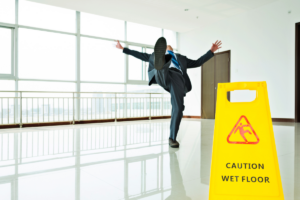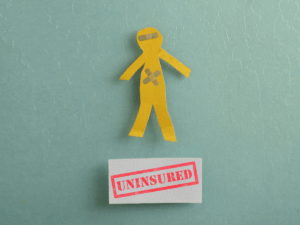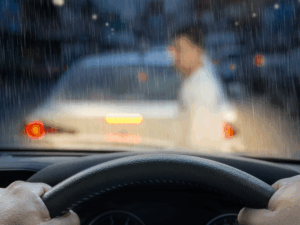How to prove liability in a slip and fall case at work or in a public space can be highly stressful. Not only might you be concerned about how your injuries could affect your ability to work, but understanding the next steps and knowing what you’re entitled to can be quite confusing.
As your Las Vegas slip and fall attorney, we will help you understand the elements required to establish liability and the types of evidence needed that can strengthen your case and improve your chances of a successful outcome. Compensation claims can be challenging to navigate, and most people are unsure where to start.

How Do Slip and Fall Accidents Occur?
Slip and fall accidents can happen in various settings when hazards are present and proper preventive measures have not been implemented. This failure to maintain a safe environment could be due to negligence by your employer, building manager, property owner, or business. Common preventive oversights include the absence of warning signs or inadequate lighting.
Here are some typical hazards that can lead to slip and fall accidents:
- Wet or freshly waxed surfaces without proper hazard signs
- Uneven ground
- Torn carpeting
- Loose or missing tiles, steps, or floorboards
- Debris cluttering walkways, especially in high-traffic areas
- Cracks in floors or sidewalks
- Uneven staircases or staircases without proper railings
- Poor lighting
- Cables scattered across the floor
- Potholes in parking lots
Understanding these potential hazards can help you be more aware of your surroundings and take necessary precautions to avoid accidents.
Proving Liability in a Slip and Fall Case: The Key Elements
To establish liability in a slip and fall accident, these critical elements must be considered:
- Duty of Care: You need to show that the property owner had a responsibility to maintain a safe environment. This means they should have ensured that their premises were free of hazards or that any potential dangers were clearly marked.
- Breach of Duty: You must prove that the property owner failed to meet this responsibility. This could involve not fixing known issues, such as wet floors, loose tiles, or poor lighting, or not providing adequate warnings about these hazards.
- Causation: It’s essential to demonstrate that this breach directly caused your injury. For instance, if you slipped on an unmarked wet floor and sustained an injury, you need to connect the property owner’s negligence to the accident.
- Damages: Finally, you must show that you suffered actual damages due to the injury. This can include medical bills, lost wages, and pain and suffering.
By clearly establishing these points, you can build a strong case to prove liability in a slip and fall accident.
Evidence to Support Your Claim: Gathering robust evidence is crucial in proving liability. Key types of evidence include:
- Photographs and Videos: Visual documentation of the accident scene and hazardous conditions.
- Witness Statements: Testimonies from people who witnessed the accident or were aware of the hazardous conditions.
- Incident Reports: Documentation of the accident by the property owner or manager.
- Medical Records: Detailed records of your injuries and treatments.
- Maintenance Records: Proof of the property owner’s negligence in maintaining safe premises.
Common Challenges in Proving Liability: Proving liability can be challenging due to several factors:
- Disputes Over Hazardous Conditions: Property owners may argue that the hazard was not dangerous or that you should have been aware of it.
- Contributory Negligence: The defense may claim that you were partially or fully responsible for the accident.
- Lack of Immediate Evidence: Delays in reporting the incident or gathering evidence can weaken your case.
Proving liability in a slip and fall case requires a thorough understanding of the legal elements and meticulous evidence gathering. At Howard Injury Law, we are your experienced personal injury lawyers and we provide invaluable assistance in navigating these challenges and ensuring that you build a strong case for maximum compensation.
Free Consultation with Howard Injury Law:
📲 702.331.5722 M-F/9-5
🗣 Se Habla Español
🗣 Wǒmen shuō
For ongoing news updates and personal injury safety tips, follow us on Instagram, Facebook, or X and stay informed. Searching for injury attorney or injury lawyer near me? Find us on Google Maps!




